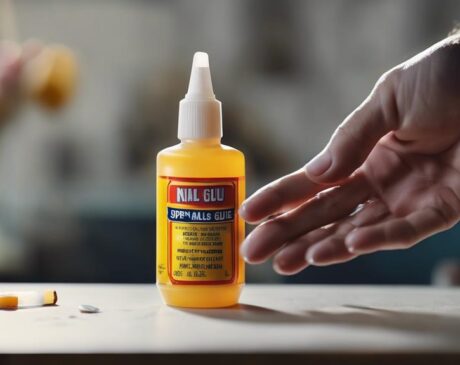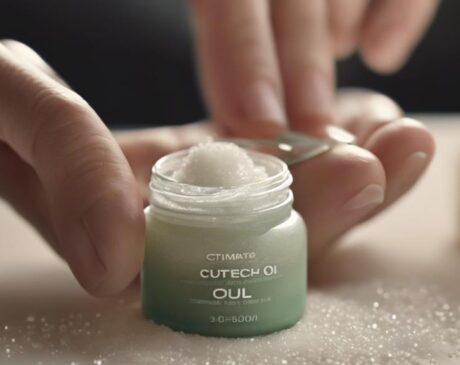What Damages Nails the Most?
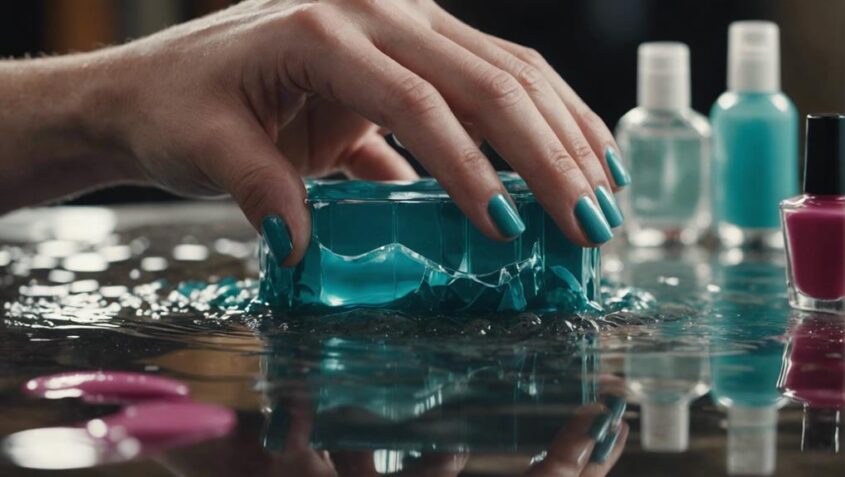
Nails can be significantly damaged by frequent manicures, exposure to harsh chemicals, nail-biting habits, lack of moisture, and underlying health conditions. Overdoing manicures weakens nails, while harsh chemicals like formaldehyde and toluene can lead to brittleness and breakage. Nail-biting weakens nails and increases infection risks, while dehydration from lack of moisture and improper care routines can harm nail health. Understanding these factors is crucial for maintaining strong and healthy nails. Further exploration of the research can provide more in-depth insights into preventing and addressing nail damage.
Key Takeaways
- Frequent manicures weaken nails, leading to breakage and brittleness.
- Exposure to harsh chemicals in nail products damages nail health.
- Nail biting habits result in weak, damaged, and irregular nails.
- Lack of moisture causes brittleness and compromises nail strength.
- Gel and acrylic use can enhance aesthetics but weaken natural nails if overused.
Frequent Manicures
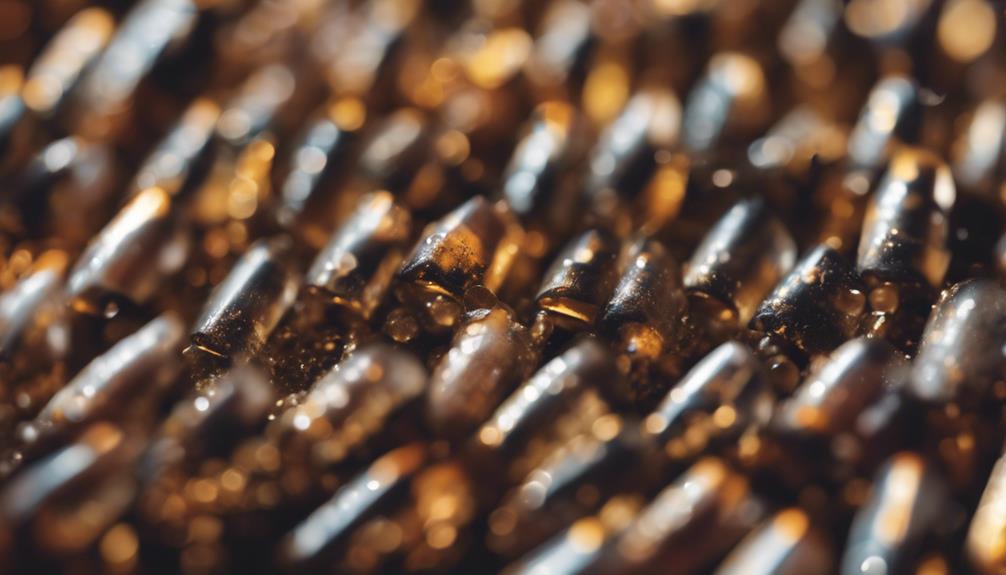
Frequent manicures, while enhancing the appearance of nails, can lead to potential damage if not done with proper care and moderation. The desire for flawlessly painted nails often drives individuals to indulge in frequent manicures, sometimes overlooking the importance of allowing nails to breathe naturally. Over time, excessive manicures can weaken the nails, making them more prone to breakage and brittleness.
Innovations in the nail industry have brought forth alternatives to traditional nail polishes that are gentler on the nails. Water-based and breathable nail polishes are becoming increasingly popular among those seeking to maintain healthy nails while still enjoying beautifully manicured hands. These innovative products offer a compromise between style and nail health, reducing the potential damage caused by frequent manicures.
To ensure that frequent manicures do not compromise the health of your nails, it is essential to incorporate regular breaks between treatments and to prioritize nail care routines that focus on hydration and strengthening. By embracing these innovative approaches, individuals can enjoy the benefits of manicures without risking the long-term health of their nails.
Harsh Chemicals
Exposure to harsh chemicals in nail products poses a significant risk to the overall health and strength of nails. These chemicals, often found in nail polishes, removers, and artificial nail products, can lead to dryness, brittleness, discoloration, and weakening of the nails over time. The innovative table below highlights some common harsh chemicals present in nail products and their potential effects on nail health:
| Chemical | Potential Effects | Safer Alternatives |
|---|---|---|
| Formaldehyde | Causes brittleness and weakening of nails | Formaldehyde-free nail products |
| Toluene | Leads to discoloration and breakage | Toluene-free nail polishes |
| DBP (dibutyl phthalate) | Contributes to nail flexibility issues | DBP-free nail treatments |
Nail Biting Habits
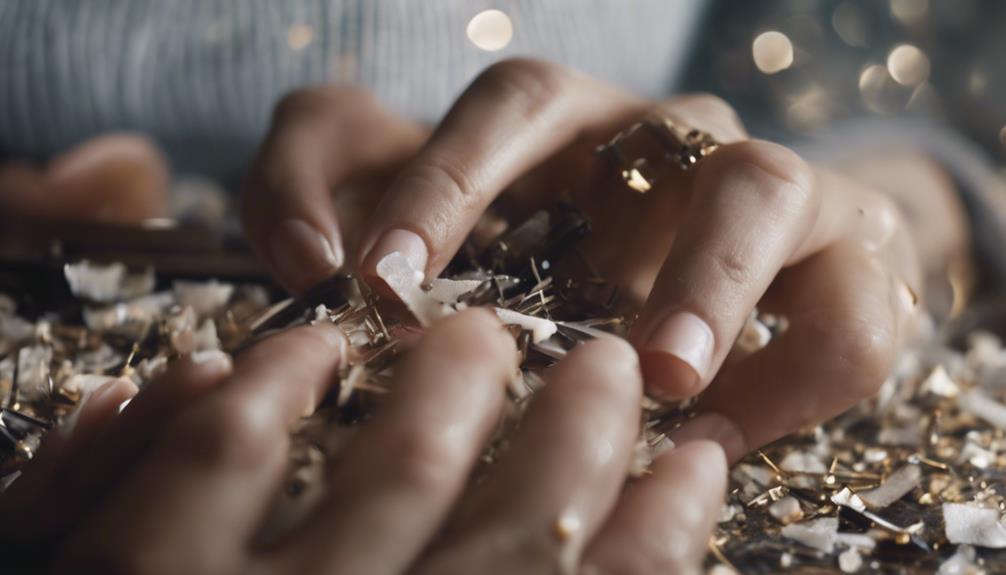
Nail biting habits can significantly impact the health and appearance of nails, leading to issues such as weak and damaged nail beds. To address this, individuals can implement various prevention techniques to break the habit and promote healthier nail growth. Understanding the effects of nail biting and adopting suitable strategies can help maintain strong and beautiful nails.
Impact of Biting
Engaging in the habit of biting nails can severely compromise the overall health and appearance of the fingernails. Nail biting not only weakens the nails but also increases the risk of infections due to the introduction of bacteria from the mouth to the fingertips. The constant biting and chewing can lead to irregular nail growth, making them more prone to breakage and peeling. Additionally, nail biting can cause damage to the surrounding skin, leading to painful hangnails and inflammation. Over time, this habit can result in deformed nail beds and a perpetually unsightly appearance. Breaking the cycle of nail biting is crucial to restoring the health and beauty of the nails, promoting overall nail strength and growth.
Prevention Techniques
To effectively curb the habit of nail biting, implementing proactive strategies that address the underlying triggers and provide alternative behaviors is essential. One innovative approach is habit reversal training, which involves increasing self-awareness to recognize when the urge to bite nails arises, followed by substituting the behavior with a more constructive action, like squeezing a stress ball or applying nail polish with a bitter taste. Additionally, cognitive-behavioral therapy can help individuals identify and challenge negative thought patterns that contribute to nail biting. Engaging in relaxation techniques, such as deep breathing or mindfulness meditation, can also aid in reducing stress levels that may trigger nail biting tendencies. By combining these strategies with patience and consistency, individuals can work towards breaking the habit of nail biting and maintaining healthier nails.
Lack of Moisture
Insufficient moisture can harm nails in various ways. Exposure to drying effects of water, harsh cleaning chemicals, and frequent application of nail polish can all contribute to brittle and weak nails. Understanding these factors is crucial in maintaining nail health and preventing damage caused by lack of moisture.
Drying Effects of Water
One of the most damaging factors to nails is the lack of moisture, which can be exacerbated by the drying effects of water. While water is essential for hydration, frequent or prolonged exposure to it can strip the nails of natural oils, leading to dryness, brittleness, and potential breakage. The drying effects of water are particularly pronounced when hands are submerged repeatedly, such as during dishwashing or frequent handwashing. To mitigate these effects, it is advisable to wear gloves when engaging in activities involving water and to moisturize the nails and cuticles regularly. By taking proactive steps to counteract the drying effects of water, individuals can help maintain the health and strength of their nails.
Harsh Cleaning Chemicals
The detrimental impact on nails can also be exacerbated by exposure to harsh cleaning chemicals, which further contributes to the lack of moisture essential for maintaining nail health. When it comes to nail damage, harsh cleaning chemicals play a significant role. Here are some innovative ways these chemicals can affect your nails:
- Stripping Natural Oils: Harsh chemicals can strip the nails of their natural oils, leading to dryness and brittleness.
- Disrupting pH Balance: The pH balance of the nails can be disrupted, making them more susceptible to damage.
- Causing Dehydration: Chemicals can dehydrate the nails, making them more prone to breakage and splitting.
- Weakening Nail Structure: Continuous exposure to harsh cleaning chemicals can weaken the overall structure of the nails, making them more fragile.
Excessive Nail Polish
Excessive application of nail polish can lead to a lack of moisture in the nails, potentially compromising their health and strength. When nails lack moisture, they become brittle and prone to breakage, ultimately affecting their appearance. Constant exposure to nail polish chemicals, along with improper removal techniques, can further exacerbate this issue. To combat the negative effects of excessive nail polish, it is essential to incorporate regular nail care routines that prioritize hydration. Using nourishing cuticle oils, moisturizing treatments, and taking breaks between manicures can help restore moisture levels and improve the overall health of the nails. Embracing a balanced approach to nail polish application and maintenance is key to preventing the detrimental consequences of dehydration in nails.
Improper Nail Care
Improper nail care practices can significantly weaken and damage the overall health of nails. To maintain the health and beauty of your nails, it is crucial to adopt proper care habits. Here are some innovative tips to help you avoid damaging your nails:
- Avoid Over-filing: Excessive filing weakens nails, leading to brittleness and breakage. Opt for gentle filing in one direction to maintain nail strength.
- Proper Hydration: Just like your skin, nails require hydration. Use a moisturizing nail and cuticle oil to keep them hydrated and prevent dryness.
- Use Protective Gloves: When doing household chores or gardening, wear protective gloves. This shields your nails from harsh chemicals and prevents them from becoming weak and brittle.
- Limit Gel and Acrylic Usage: While gel and acrylic nails can enhance aesthetics, frequent use can weaken your natural nails. Give your nails breaks between applications to allow them to breathe and recover.
Health Conditions
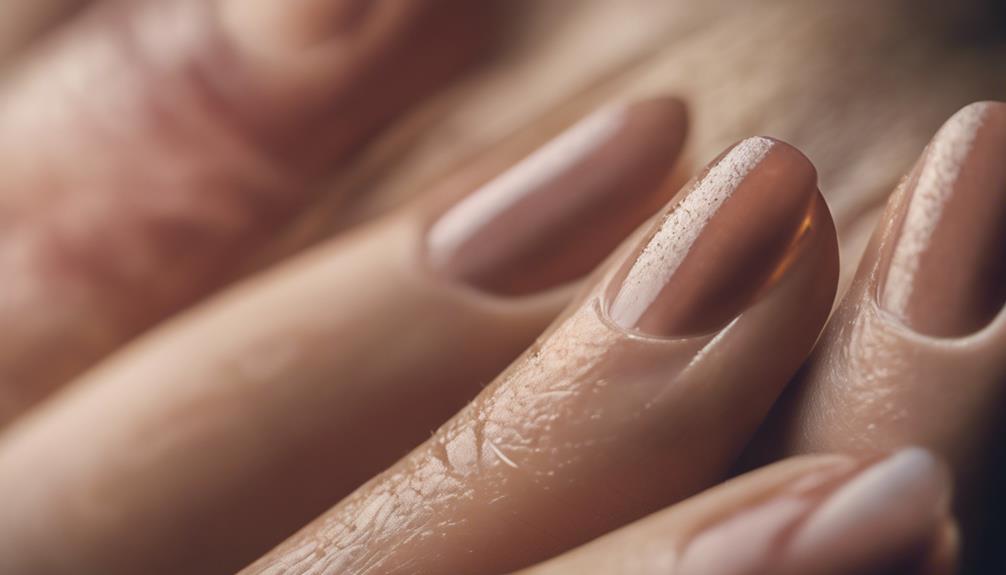
Weak and damaged nails can also be influenced by various health conditions that affect their overall strength and appearance. Conditions such as psoriasis, eczema, and thyroid disorders can have a significant impact on the health of nails. Psoriasis can cause nail pitting, ridges, and discoloration, leading to brittleness. Eczema, characterized by inflammation and itchiness, can affect the nail bed, resulting in irregular nail growth. Thyroid imbalances, whether hypothyroidism or hyperthyroidism, may lead to brittle, dry, or thin nails due to hormonal disruptions.
Furthermore, deficiencies in essential nutrients like biotin, iron, and zinc can manifest through brittle and weak nails. Poor absorption of nutrients, often linked to gastrointestinal conditions such as celiac disease, can also contribute to nail problems. Diabetes, circulation issues, and liver or kidney diseases can impact nail health by causing discoloration, changes in shape, or slow growth.
Understanding the connection between these health conditions and nail health is crucial in addressing underlying issues to promote stronger, healthier nails. Consulting with healthcare professionals for proper diagnosis and treatment is essential for managing these conditions and improving nail strength and appearance.
Frequently Asked Questions
Can Certain Medications Affect the Health of Nails?
Certain medications can indeed affect nail health. Factors such as drug composition, dosage, and duration of use can impact nail strength and appearance. It is advisable to consult healthcare professionals for guidance on managing any nail-related concerns during medication use.
How Can Stress Impact the Condition of Nails?
Stress, a relentless adversary, can disrupt the delicate balance of nail health. This psychological pressure may lead to brittle, slow-growing nails, and in severe cases, even cause conditions like onycholysis. Managing stress is key for nail well-being.
Are There Specific Dietary Factors That Contribute to Nail Damage?
Dietary factors significantly impact nail health. Nutrient deficiencies, especially biotin, iron, zinc, and protein, can weaken nails, leading to brittleness and breakage. Consuming a balanced diet rich in vitamins and minerals is crucial for maintaining strong and healthy nails.
Can Environmental Factors Like Weather Affect Nail Health?
Just as a tree's growth can be shaped by the elements, weather impacts nail health. Extreme conditions like cold, heat, or humidity can weaken nails. Protecting them with proper care and products is crucial.
What Role Do Genetics Play in the Strength of Nails?
Genetics play a crucial role in determining the strength of nails. Variations in genes can influence nail structure, thickness, and overall health. Understanding genetic predispositions can provide insights into personalized nail care routines and treatments for optimal nail strength.

